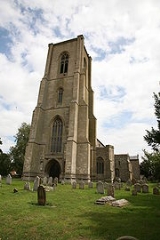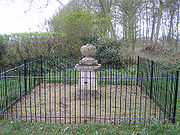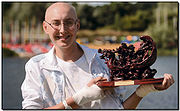
Cawston, Norfolk
Encyclopedia
Cawston is a small village located approximately 11 miles (17.7 km) North of Norwich
, off the B1149
main road to Holt
. Nearby villages are Reepham and Aylsham
.
 At the centre of the village lies the mediaeval perpendicular parish church
At the centre of the village lies the mediaeval perpendicular parish church
of St Agnes
, which is a Grade I listed building. Erected at the end of the 14th century a truly big Perpendicular decorated Church, that dwarfs the small village of Cawston. The tower stands at 120 feet. A deeply moulded doorway with a wodehouse or wild man and a dragon. The crest of De La Pole family was the head of a wild man. The De Pole's were the Earls of Suffolk who largely rebuilt this magnificent church and its mighty tower in the early 15th century.http://www.imagesofengland.org.uk/details/default.aspx?id=227993.
s. 1 shows two women facing each other, 1 is a portrait of a man, and finally a stag's head surrounded by foliage.
 The year 1698 saw an event which had featured in many guide books and directories, when on August 20 the last duel fought in Norfolk took place on Cawston Heath. The contestants were Sir Henry Hobart MP
The year 1698 saw an event which had featured in many guide books and directories, when on August 20 the last duel fought in Norfolk took place on Cawston Heath. The contestants were Sir Henry Hobart MP
of Blickling Hall
and Oliver Le Neve, a lawyer from Great Witchingham
. Le Neve, described as a great sportsman and a great drinker, fought left-handed and was soon wounded in the arm by Sir Henry who had a reputation as a swordsman.
However, Le Neve then struck back and injured his opponent so badly that he died next day at Blickling
. As there appear to have been no seconds or witnesses, the duel was illegal. Le Neve fled to Holland but returned to England two years later, having received a pardon.
It is said locally that details of the duel came from a girl who was hiding in the bushes, and tales are still told of this unfortunate event which is commemorated by the Duel Stone which stands in a small National Trust
plot near the Woodrow Garage, Norwich Road, Cawston.
Cawston village hall and play park are in the village.
Compulsory education came with the passing of the 1870 Education Act, and it was on March 6, 1871, that the Rector opened the school at Cawston with 92 pupils on the books, in the care of Mrs. Bilby as Head Teacher, assisted by Mr. Bilby. On the 24th May 1890 the school had a holiday for the birthday of Queen Victoria and the Relief of Mafeking. In the immediate post-war years the school was "bursting at the seams", with more than 180 children in the four classrooms, two of which were divided by a curtain. Playground space was very small, and PE lessons were taken on the strip of road outside the school entrance. Games were played on the Homestead at the back of Church Farm, where the annual sports were held, and the village football team played its home matches. School meals were introduced in 1949 and were served in two sittings in the present Scout Hut near the Rectory, a charge being one shilling per meal for the first child, 4d for the second, and 3d for subsequent children in a family. On May 5, 1953 the new school building came into use, and on July 20, the school was officially opened by Dr. F. Lincoln Ralphs, Chief Education Officer for Norfolk. The vastly improved facilities, particularly the playing field, were welcomed. In 1957 the school was reorganised as a Junior and Infant School, the seniors (11+) being transferred to the new school at Aylsham, pending the completion of the Reepham High School, which the Seniors now attend.
 26 September 1990 – 23 November 2006
26 September 1990 – 23 November 2006
Sufferer of Acute Myeloid Leukaemia, which took his life on the 23 November 2006 at age 16. Born 26 September 1990, Matthew lived all his life in Cawston.
First diagnosed in November 2005, Fletcher achieved fame for his constant struggle against the illness while studying at Reepham High School, Norfolk, UK. He is credited for doing much to raise awareness for Leukaemia sufferers, particularly through his work with the Anthony Nolan Trust. His work and life earned him considerable attention in the local newspaper, the Eastern Daily Press
, often to the size of double-page-inside spreads.
Matthew recorded an audio diary for BBC Radio Norfolk
. Extracts from this audio diary were played on the BBC Radio 4
programme "Pick of the Week" presented by Robin Lustig
.
The week before his death Matthew was given the “Community Student of the Year” award from Reepham High School and a recorded video message from him was played to the school.
Norwich
Norwich is a city in England. It is the regional administrative centre and county town of Norfolk. During the 11th century, Norwich was the largest city in England after London, and one of the most important places in the kingdom...
, off the B1149
B1149 road
The B1149 is the most direct route between the town of Holt and the city of Norwich in the county of Norfolk, England. There is no direct A-road alternative...
main road to Holt
Holt, Norfolk
Holt is a market town and civil parish in the English county of Norfolk. The town is north of the city of Norwich, west of Cromer and east of King's Lynn. The town is on the route of the A148 King's Lynn to Cromer road. The nearest railway station is in the town of Sheringham where access to the...
. Nearby villages are Reepham and Aylsham
Aylsham
Aylsham is a historic market town and civil parish on the River Bure in north Norfolk, England, about north of Norwich. The river rises near Melton Constable, upstream from Aylsham and continues to Great Yarmouth and the North Sea, although it was only made navigable after 1779, allowing grain,...
.
Church of St Agnes

Parish church
A parish church , in Christianity, is the church which acts as the religious centre of a parish, the basic administrative unit of episcopal churches....
of St Agnes
Saint Agnes
Agnes of Rome is a virgin–martyr, venerated as a saint in the Roman Catholic Church, Eastern Orthodox Church, the Anglican Communion, and Lutheranism. She is one of seven women, excluding the Blessed Virgin, commemorated by name in the Canon of the Mass...
, which is a Grade I listed building. Erected at the end of the 14th century a truly big Perpendicular decorated Church, that dwarfs the small village of Cawston. The tower stands at 120 feet. A deeply moulded doorway with a wodehouse or wild man and a dragon. The crest of De La Pole family was the head of a wild man. The De Pole's were the Earls of Suffolk who largely rebuilt this magnificent church and its mighty tower in the early 15th century.http://www.imagesofengland.org.uk/details/default.aspx?id=227993.
Misericords
St Agnes contains three 15th century misericordMisericord
A misericord is a small wooden shelf on the underside of a folding seat in a church, installed to provide a degree of comfort for a person who has to stand during long periods of prayer.-Origins:...
s. 1 shows two women facing each other, 1 is a portrait of a man, and finally a stag's head surrounded by foliage.
Tourist attractions

Sir Henry Hobart, 4th Baronet
Sir Henry Hobart, 4th Baronet was an English Whig politician and baronet.-Background:He was the oldest son of Sir John Hobart, 3rd Baronet and his first wife Mary Hampden, daughter of John Hampden...
of Blickling Hall
Blickling Hall
Blickling Hall is a stately home in the village of Blickling north of Aylsham in Norfolk, England, that has been in the care of the National Trust since 1940.-History:...
and Oliver Le Neve, a lawyer from Great Witchingham
Great Witchingham
Great Witchingham is a village and civil parish in the English county of Norfolk about north-west of Norwich.It covers an area of and had a population of 564 in 235 households as of the 2001 census....
. Le Neve, described as a great sportsman and a great drinker, fought left-handed and was soon wounded in the arm by Sir Henry who had a reputation as a swordsman.
However, Le Neve then struck back and injured his opponent so badly that he died next day at Blickling
Blickling
Blickling is a village and civil parish in the Broadland district of Norfolk, England, about north-west of Aylsham on the B1354 road. According to the 2001 census it had a population of 136 and covers . Since the 17th century the village has been concentrated in two areas, around the church and...
. As there appear to have been no seconds or witnesses, the duel was illegal. Le Neve fled to Holland but returned to England two years later, having received a pardon.
It is said locally that details of the duel came from a girl who was hiding in the bushes, and tales are still told of this unfortunate event which is commemorated by the Duel Stone which stands in a small National Trust
National Trust for Places of Historic Interest or Natural Beauty
The National Trust for Places of Historic Interest or Natural Beauty, usually known as the National Trust, is a conservation organisation in England, Wales and Northern Ireland...
plot near the Woodrow Garage, Norwich Road, Cawston.
Cawston village hall and play park are in the village.
Education
In 1863 a reading room was opened at Oak House. At that time reading was still considered an accomplishment, eight years before the opening of our village school. A visitor to Cawston a few years ago told of how one of her ancestors used to go to the Friendship Inn at Eastgate, where he lived, to read the weekly paper to his friends. There were "private schools" here at that time and in the Norfolk Directory for 1845 the names of two "schoolmasters" appear, William Wells and Robert Yallop.Compulsory education came with the passing of the 1870 Education Act, and it was on March 6, 1871, that the Rector opened the school at Cawston with 92 pupils on the books, in the care of Mrs. Bilby as Head Teacher, assisted by Mr. Bilby. On the 24th May 1890 the school had a holiday for the birthday of Queen Victoria and the Relief of Mafeking. In the immediate post-war years the school was "bursting at the seams", with more than 180 children in the four classrooms, two of which were divided by a curtain. Playground space was very small, and PE lessons were taken on the strip of road outside the school entrance. Games were played on the Homestead at the back of Church Farm, where the annual sports were held, and the village football team played its home matches. School meals were introduced in 1949 and were served in two sittings in the present Scout Hut near the Rectory, a charge being one shilling per meal for the first child, 4d for the second, and 3d for subsequent children in a family. On May 5, 1953 the new school building came into use, and on July 20, the school was officially opened by Dr. F. Lincoln Ralphs, Chief Education Officer for Norfolk. The vastly improved facilities, particularly the playing field, were welcomed. In 1957 the school was reorganised as a Junior and Infant School, the seniors (11+) being transferred to the new school at Aylsham, pending the completion of the Reepham High School, which the Seniors now attend.
Matthew Fletcher

Sufferer of Acute Myeloid Leukaemia, which took his life on the 23 November 2006 at age 16. Born 26 September 1990, Matthew lived all his life in Cawston.
First diagnosed in November 2005, Fletcher achieved fame for his constant struggle against the illness while studying at Reepham High School, Norfolk, UK. He is credited for doing much to raise awareness for Leukaemia sufferers, particularly through his work with the Anthony Nolan Trust. His work and life earned him considerable attention in the local newspaper, the Eastern Daily Press
Eastern Daily Press
The Eastern Daily Press, commonly referred to as the EDP, is a regional newspaper covering Norfolk, and northern parts of Suffolk and eastern Cambridgeshire, and is published daily in Norwich, UK....
, often to the size of double-page-inside spreads.
Matthew recorded an audio diary for BBC Radio Norfolk
BBC Radio Norfolk
BBC Radio Norfolk is the BBC Local Radio service for the English county of Norfolk, broadcasting since 11 September 1980. It broadcasts from the studios of BBC East in The Forum, Norwich on 95.1 FM , 104.4 FM , 95.6 FM , 855 kHz AM/MW , 873 kHz AM/MW BBC Radio Norfolk is the BBC Local...
. Extracts from this audio diary were played on the BBC Radio 4
BBC Radio 4
BBC Radio 4 is a British domestic radio station, operated and owned by the BBC, that broadcasts a wide variety of spoken-word programmes, including news, drama, comedy, science and history. It replaced the BBC Home Service in 1967. The station controller is currently Gwyneth Williams, and the...
programme "Pick of the Week" presented by Robin Lustig
Robin Lustig
Robin Francis Lustig is a BBC journalist and radio broadcaster who presents programmes for the BBC World Service and BBC Radio 4.- Early Career :...
.
The week before his death Matthew was given the “Community Student of the Year” award from Reepham High School and a recorded video message from him was played to the school.

